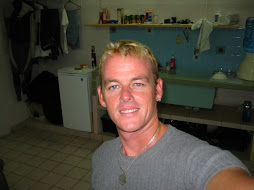So here is a little fresh stuff for the blog.
 Diver tip Buoyancy Control
Diver tip Buoyancy ControlAs an instructor here in Cozumel now for more than 7 years I have seen all kinds of students. Every student responds differently and across the board the hardest skill for them to master is buoyancy. It is also the skill I think is the most important and makes a good diver a great diver.
The basic idea is to control the amount of air you have in your lungs to maintain neutral flotation, neither sinking nor floating. It makes you more efficient because you don’t need to do anything but breathe to hold your position. This is an extra nice benefit here in Cozumel because we are always drift diving. There are many techniques for teaching the basic idea. PADI teaches the fin pivot (laying flat on the bottom and inhaling and exhaling to find neutral) and the hover (staying a couple feet above the bottom with legs crossed and perfectly still) in order to master the skill. For most skilled divers it comes down to feeling when you are neutral. A seasoned diver can feel if they are moving up or down with each breath and they time the inhale, exhale and volume of air they breathe accordingly.
Here is an example. If you feel any time during your dive like you are falling, if your hands are flapping in front of you like a rubber chicken, if you are unknowingly kicking your fins feet down in order to keep from sinking, if you are making a big dust cloud below you as you descend, if you ever run into the coral reef below, then you are negatively buoyant and you need to either breath more deeply or add a few puffs of air into your BCD.
In contrast to that, if you are facing down just so your feet are above you and swimming down, if you are holding onto/reaching for a dive buddy below to pull you down, if you are waving your hands palms up to try and sink, if you always ask for more lead from the dive master who knows to bring some extra just for you, then you can be pretty sure you are positively buoyant and need to dump some air out of your BCD or breathe more shallow. Many seasoned divers will actually put just the right amount of lead on so that when their tank is empty during the safety stop, they have to breathe shallower just to stay under.
One technique I find helps divers learn during a peak performance buoyancy dive is to try to stay within 6-10 inches off the bottom. While flat out in the dive position it is hard to inflate or deflate your BCD and flapping your hands or fins does more harm than good. So in that position, so close to the bottom, your lungs are your only way to keep from touching down. Try it next time you are geared up, see just how close you can get to the bottom without touching. In cave diving it is routine to get that close to the bottom without touching the roof or the bottom in a narrow passage. An advanced way to practice this is actually to turn upside down, feet straight up and see how close you can get your head to the bottom without getting sand in your hair.
Mastering your buoyancy is one of the hardest skills for any diver. There is no way I can get into all the details of it here. When you finally find that it is inherent and you do it without thinking about it you will find your air consumption drops by 20-40% and you end up seeing more and enjoying the dives more every time.
Stay tuned for next month when I go into the finer points of trim and positioning while diving.


